#Bollywood Songs of 1967
Explore tagged Tumblr posts
Text

Birthday greetings to the living music legend of the Hindi film industry, Sri #Pyarelal Ramprasad Sharma (03/09).
The iconic music director duo #LaxmikantPyarelal is synonymous with Hindi film music, particularly its popular hits. Born on September 3, 1940, Pyarelal Ramprasad Sharma is the son of the renowned trumpeter, Pandit Ramprasad Sharma, also known as Babaji. Under his father's guidance, Pyarelal started learning the violin at just 8 years old, dedicating 8 to 12 hours daily to practice. He further refined his violin skills under Goan musician Anthony Gonsalves. The song "My Name Is Anthony Gonsalves" from the film Amar Akbar Anthony is a tribute to Gonsalves, featuring music by the Laxmikant–Pyarelal duo.
At 12, Pyarelal began playing the violin in various studios, including Ranjit Studios, to support his family financially. His brother, Gorakh Sharma, also contributed by playing guitar for songs composed by Laxmikant-Pyarelal.
The duo first gained widespread recognition with their music for the 1964 film Dosti, produced by Rajshri Productions. Despite relatively unknown lead actors, the film's memorable songs like "Chahoonga Main Tujhe Shaam Savere" and "Rahi Manwa" made it a hit. Many initially thought Laxmikant–Pyarelal was a single person. They won their first Filmfare Award for Best Music Director for Dosti, beating industry giants like Shankar–Jaikishan and Madan Mohan. Their subsequent work in films like Lootera, which featured famous Lata Mangeshkar songs, also gained fame.
By 1966, Laxmikant–Pyarelal had firmly established themselves in Bollywood. They continued to earn acclaim for their music in films like Aaye Din Bahar Ke and Pyar Kiye Jaa. In 1967, they had a series of hits, including the Golden Jubilee musical hit Farz, and other big-star films like Anita and Shagird. They won their second Filmfare Award for the film Milan.
Laxmikant–Pyarelal, along with contemporaries like Rahul Dev Burman and Kalyanji-Anandji, represented a new era in Bollywood music, overshadowing earlier composers. They were frequently chosen by major film producers and consistently delivered exceptional music.
Their significant collaboration with lyricist Anand Bakshi led to some of Bollywood’s most iconic songs, appearing in over 250 films. Anand Bakshi wrote the lyrics for all the films that earned Laxmikant–Pyarelal Filmfare Awards, except for their first. #RajeshKhanna also had a long-standing professional relationship with the duo, choosing them as the music directors for 26 of his films.
Another fruitful partnership was with singer Asha Bhonsle, who voiced numerous hits composed by Laxmikant–Pyarelal, including chart-toppers like "Dhal Gaya Din" and "Hungama Ho Gaya." The latter song was re-recorded for the 2014 film Queen and became a massive hit again. Between 1980 and 1986, Asha Bhonsle was often the lead vocalist for their compositions. Laxmikant–Pyarelal also scored music for the Telugu film Majnu in 1987, which was well-received for its musical numbers.
2 notes
·
View notes
Text
Movie Ask Game #12 and #19
A response to @shimako, who wrote:
"12,18 and 19 for the movie asks if you still play it 😊. Love your blog btw!"
Thanks for the kind words! See this post for question #18 (the one about movie posters). The others are below.
12. Which movie has your favorite soundtrack?
Oh, so many good ones! I actually used to sort of collect soundtracks, and I couldn't possibly choose just one. I'm going to concentrate on instrumental soundtracks, rather than musicals or the "collection of pop songs" type of soundtrack. And I'm completely skipping Bollywood, because that would be another whole post! But here's a short list below...
Nino Rota's soundtracks for Romeo and Juliet (1968) and the lesser known Taming of the Shrew (1967) are both great.
John Williams' original Star Wars score (1977) is a classic for a very good reason!
Back to Shakespeare, Patrick Doyle's Henry V soundtrack (1989). I also like his soundtracks for Dead Again (1991) and Brave (2013).
Bryce Dessner's soundtrack for Cyrano de Bergerac (1991) is full of Baroque splendor and deserves to be better known.
Klaus Badelt et al for the original Pirates of the Caribbean (2006).
Harry Gregson-Williams for Prince of Persia: The Sands of Time (2010).
Absolutely anything by Joe Hisaishi for a Ghibli movie! I also really loved Cecile Corbel's soundtrack for The Secret World of Arietty (2010) and was appalled that the US release cut the last song.
19. What part of filmmaking do you find most interesting (ie. sound design, costuming, set design, etc)?
Well, of course, costuming is what I find interesting enough to have a whole blog about! But in addition to that, I'm rather fascinated by editing. It's amazing what a difference it can make in the focus of a scene or a film.
5 notes
·
View notes
Text
Relationship: A Complex Web of Emotions and Bonds
What relationships have a positive impact on you? "Ram Kare Aisa Ho JaayeMeri Nindiya Tohe Mil JaayeMain Jagoon, Tu So Jaye..." -Film "Milan" 1967 Before starting the commentary on relationships, quoting two Bollywood film songs of the same year, 1967, would be appropriate. The first one is quoted above. It expresses the extreme love of a lover who prays to God to…
#dailyprompt#dailyprompt-2168#Family#family values#Negative and Positive#Nuclear family#Society#who is positively impactful in a family
0 notes
Text
The Musical Genius of AR Rahman: A Journey Through His Iconic Compositions

Introduction
AR Rahman, often referred to as the "Mozart of Madras," is a name that resonates with music lovers around the globe. From his early beginnings in India to his rise as an internationally acclaimed composer, AR Rahman has left an indelible mark on the music industry. His unique blend of Indian classical music, world music influences, and modern electronic sounds has created a sound that is unmistakably his own. Over the years, AR Rahman’s compositions have not only defined the soundtracks of countless Bollywood blockbusters but have also earned him accolades, including two Academy Awards, multiple Grammy Awards, and the hearts of millions. This blog explores the genius of AR Rahman and takes a journey through some of his most iconic compositions, revealing how his music continues to inspire and captivate audiences.
The Early Years: A Rising Star
Born in Chennai, India, in 1967, AR Rahman’s early life was steeped in music. His father, RK Shekhar, was a composer and conductor for All India Radio, which provided Rahman with an early exposure to the world of sound. Tragically, his father passed away when Rahman was just nine years old, and it was during this challenging time that he first encountered the transformative power of music.
Despite his early experiences, Rahman initially struggled to find a stable career in music. His pursuit of higher studies led him to the Trinity College of Music in London, where he honed his skills in music composition and arrangement. Upon his return to India, Rahman quickly became known for his innovative approach to music production. It was during this period that he adopted the name "AR Rahman," and his journey towards becoming a musical legend began.
The Breakthrough: Roja and the Birth of a New Sound
In 1992, AR Rahman’s career skyrocketed with the release of the soundtrack for the Tamil film Roja. This was a turning point not just for Rahman, but for the entire Indian music industry. Roja was unlike anything Indian audiences had heard before. The fusion of Indian classical music with contemporary electronic elements created a refreshing, bold new sound. Tracks like “Chhoti Si Aasha” and “Roja Jaaneman” became instant hits, and Rahman’s distinctive style was born.
Roja was not just a success in India, but also internationally, marking the beginning of AR Rahman’s global recognition. It was a masterclass in blending East and West, drawing from the rich traditions of Indian classical music while embracing modern technology. This blend of tradition and innovation would become a hallmark of Rahman’s music throughout his career.
Expanding Horizons: Bollywood and International Recognition
As AR Rahman’s fame spread across India, so did his reach. He was soon sought after by Bollywood filmmakers, who were eager to work with the composer who had revolutionized music. Rahman’s collaborations with filmmakers like Mani Ratnam and Subhash Ghai led to some of the most iconic soundtracks in Indian cinema.
One of his most unforgettable Bollywood contributions was the soundtrack for Dil Se (1998). With tracks like “Chaiyya Chaiyya,” "Jiya Jale," and “Dil Se Re,” Rahman once again showcased his ability to blend different genres, creating songs that were as much about emotion as they were about melody. Dil Se marked a new phase in Rahman’s career, where his music became an integral part of the narrative, enhancing the emotional impact of the films.
During the same period, Rahman’s global profile continued to grow. He composed the music for the stage adaptation of The Lord of the Rings in 2007 and contributed to numerous international projects. However, it was his work on Slumdog Millionaire (2008) that truly cemented his status as a global music icon. His Oscar-winning score for the film was a breathtaking fusion of Indian and Western musical traditions, and songs like “Jai Ho” became anthems of hope and triumph worldwide.
The AR Rahman Sound: A Unique Blend of Cultures
One of the defining aspects of AR Rahman’s music is his ability to bridge cultural divides. His compositions are marked by a deep reverence for Indian classical music, but Rahman’s ability to incorporate electronic music, jazz, blues, and other global genres into his work has made him one of the most innovative composers in the world.
For instance, in Taal (1999), Rahman created a soundtrack that showcased his ability to fuse the traditional with the modern. The film’s songs, such as “Nazar Ke Samne” and “Ishq Bina,” featured a mesmerizing blend of classical Indian instruments with contemporary sounds. This marked Rahman’s mastery over both indigenous and global musical elements, creating a sound that is uniquely his.
Moreover, Rahman’s use of soundtracks for narrative storytelling is unmatched. His music has an innate ability to evoke emotions and set the tone for a scene, whether it’s the romantic tension in Guru (2007) or the heart-wrenching despair in Rockstar (2011). Each composition tells a story and adds depth to the film's visual narrative.
AR Rahman and His Personal Life: Balancing Fame and Privacy
While AR Rahman’s professional life has been marked by unparalleled success, his personal life remains relatively private. Rahman married Saira Banu in 1995, and the couple has three children. While Rahman’s career was soaring, there were rumors and speculations about his personal life, including the topic of “AR Rahman and Saira Banu divorce.” However, despite such rumors, Rahman has always maintained a dignified silence, preferring to focus on his work and the music that has touched millions of hearts worldwide.
The Legacy of AR Rahman: A Musical Icon for the Ages
Today, AR Rahman stands as a symbol of excellence in the world of music. His contributions to Indian cinema, world music, and global entertainment are unparalleled. Rahman’s impact goes beyond his awards and accolades; his music has touched the souls of people from all walks of life, from India to the United States, from Africa to the Middle East.
As he continues to compose music for films, stage productions, and other artistic ventures, it is clear that AR Rahman’s legacy will endure for generations to come. His ability to blend cultures, innovate within genres, and create melodies that resonate with the human spirit ensures that his place in music history is firmly secured.
Conclusion
In conclusion, AR Rahman’s musical genius is not just defined by his award-winning compositions or groundbreaking collaborations. It lies in his ability to transcend borders—both geographical and cultural—through his music. His compositions have not only redefined the landscape of Indian cinema but have also made a profound impact on global music. As we continue to celebrate his iconic compositions, it’s clear that AR Rahman is not only a musical legend but also a true visionary whose influence will continue to inspire artists and fans for years to come.
His incredible journey, marked by triumphs like Roja, Dil Se, and Slumdog Millionaire, serves as a testament to his boundless creativity and deep connection with the world around him. Whether it’s through his collaborations, his personal life, or his masterpieces, AR Rahman’s music will always remain a beacon of artistic brilliance, leaving an everlasting legacy in the world of music.
0 notes
Text
The Cultural Impact of Daler Mehndi on Indian Pop Music
Daler Mehndi, a name synonymous with vibrant beats and energetic performances, is a cultural phenomenon in Indian music. Known for his pioneering role in popularizing Bhangra globally, Daler Mehndi’s journey from humble beginnings in Patna to becoming an international music icon is a testament to his talent and determination. This article delves into the life of Daler Mehndi, exploring how he revolutionized Punjabi music and carved out a legacy that continues to inspire artists worldwide.
Early Life and the Seeds of Music
Born Daler Singh on August 18, 1967, in Patna, Bihar, into a Punjabi Sikh family, Mehndi’s musical roots were deeply ingrained in his upbringing. From an early age, he was exposed to the rich tradition of Punjabi music, courtesy of his parents. His father, a farmer, recognized his talent and supported his musical aspirations. By the age of six, Daler was already performing shabads (Sikh devotional songs), showcasing a vocal prowess that would later define his career.
At 13, Mehndi gave his first public performance in Jaunpur, Uttar Pradesh, captivating an audience of 20,000 with his magnetic presence. This marked the beginning of a journey fueled by passion and relentless effort. Despite societal pressures and limited opportunities, Mehndi remained steadfast in his dream of pursuing music.
The Breakthrough: “Bolo Ta Ra Ra”
Mehndi’s path to fame wasn’t an overnight success. In 1991, he formed a musical group with his brothers, cousins, and friends, performing at local events and building a fan base. However, his big break came in 1995 with the release of his debut album, Bolo Ta Ra Ra. The album was an instant hit, selling over 20 million copies and earning Mehndi the prestigious Channel V’s Best Indian Male Pop Artist Award.
The success of Bolo Ta Ra Ra was unprecedented. The album blended traditional Punjabi rhythms with contemporary beats, creating a sound that was both unique and universally appealing. Mehndi’s vibrant stage presence and powerful voice resonated with audiences, catapulting him into the limelight. His music not only appealed to the Indian diaspora but also garnered international attention, making him one of the first Indian artists to achieve global recognition in the pop genre.
A String of Hits: The Rise of a Superstar
Following the massive success of his debut, Mehndi released a series of chart-topping albums, including Dardi Rab Rab and Balle Balle. Each album showcased his ability to innovate while staying true to his Punjabi roots. His songs became anthems for celebrations, with their catchy tunes and energetic beats dominating dance floors across the globe.
One of Mehndi’s most iconic contributions to music came in 1998 with the release of Tunak Tunak Tun. The song’s groundbreaking music video, featuring advanced visual effects and Mehndi’s multiple avatars, became a global phenomenon. At a time when music videos were still a novelty in India, Mehndi’s creative vision set new standards for the industry. The video’s viral success transcended linguistic and cultural barriers, cementing his status as a pioneer in Indian pop music.
Challenges and Triumphs
Mehndi’s rise to fame wasn’t without its challenges. The 1990s saw a music industry dominated by Bollywood soundtracks, leaving little room for independent artists. However, Mehndi’s distinctive style and relentless pursuit of innovation allowed him to break through these barriers. His ability to fuse traditional Bhangra with contemporary elements created a niche that resonated with audiences worldwide.
Additionally, Mehndi’s flamboyant persona and bold fashion choices made him a trendsetter. His brightly colored turbans, flowing robes, and signature dance moves became symbols of his larger-than-life personality, further endearing him to fans.
Global Impact: Bringing Bhangra to the World Stage
Daler Mehndi’s influence extends far beyond India. His music has been featured in international films, commercials, and cultural events, introducing global audiences to the rich traditions of Punjabi music. He has performed at prestigious venues worldwide, sharing stages with renowned artists and earning accolades for his contributions to music.
Moreover, Mehndi’s ability to adapt to changing trends has kept him relevant in an ever-evolving industry. He continues to collaborate with contemporary artists, blending his signature style with modern genres to create fresh and exciting music.
Inspiration for the Next Generation
Mehndi’s journey from a small-town singer to a global icon serves as an inspiration for aspiring artists. His story highlights the importance of staying true to one’s roots while embracing innovation. For independent musicians, Mehndi’s success is a reminder that passion, perseverance, and originality are key to making a mark in the industry.
Through his music, Mehndi has not only entertained millions but also created a platform for Punjabi culture to thrive on a global scale. His legacy is a testament to the power of cultural pride and artistic expression.
Celebrating a Legend
Daler Mehndi rise to stardom is a story of resilience, creativity, and cultural celebration. His contributions to music have transcended boundaries, earning him a place among the legends of Indian pop. As we celebrate his achievements, we are reminded of the impact one artist can have in shaping the cultural narrative of a nation.
Rediscover the magic of Daler Mehndi’s music by revisiting his classic hits like Bolo Ta Ra Ra and Tunak Tunak Tun. Share your favorite Daler Mehndi song on social media and tag your friends to spread the joy of his timeless beats. Let’s keep the Bhangra spirit alive!
0 notes
Text
Sharmila Tagore in Bengali cinema is a beauty that captivates you but Sharmila Tagore in Hindi cinema is usually a million volt bolt of lightening that strikes you.
This song from An Evening in Paris (1967) alone is enough to convince just how stunning Sharmila Tagore is. Highly recommend watching the whole song, it's a whole experience and I think no amount of GIFs can do it justice.
youtube
Aradhana (1969)


Anupama (1966)




The propaganda in the main post mentions Sharmila Tagore's iconic beehive, but she also has the most on point eyeliner in 60s Bollywood.
If you survived the million volts here's Sharmila Tagore looking ethereal in Bengali cinema.
Sesh Anka (1963)



Barnali (1963)

Nayak (1966)


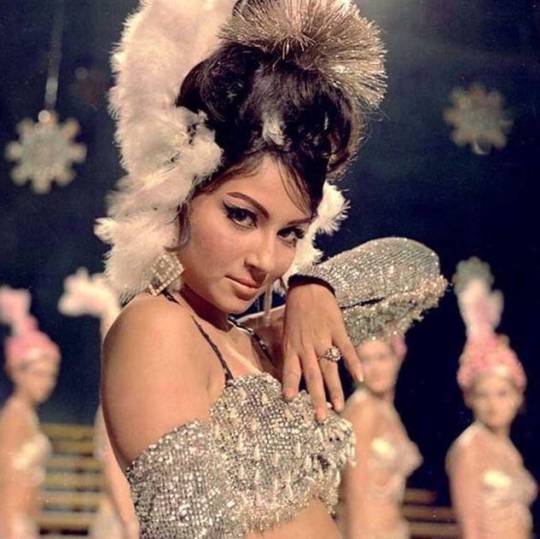
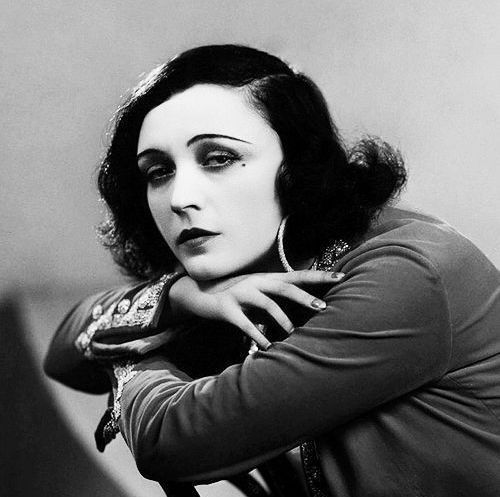
Propaganda
Sharmila Tagore (Apur Sansar, Kashmir ki Kali, An Evening in Paris)—She was adorable, an actual princess (through marriage), the first woman to wear a bikini in a Hindi film, and had, I would argue, the most iconic beehive hair in film history.
Pola Negri (The Wildcat, Men, A Woman Commands)—Legally obliged to submit her as she's from Poland, but also it is one of the greatest stars of silent film, both in Hollywood and Europe, so she has to be here. The og femme fatale and a fenomenal dramatic actress. And just so hot in this 1920s vamp style. Obviously her career slowed down in America with the introduction of sound movies, because of her accent and low voice. I'd say her voice is so much hotter thanks to that, but I'm just a simple simp. But then she made movies in Germany, and after the war she was even offered Gloria Swanson's role in "Sunset Boulevard'' but she declined. She was probably bisexual as after romances with Charlie Chaplin and Rudolf Valentino in the 20s, since the 1940s she lived with her 'female friend'.
This is round 3 of the tournament. All other polls in this bracket can be found here. Please reblog with further support of your beloved hot sexy vintage woman.
[additional propaganda submitted under the cut.]
Sharmila Tagore propaganda:

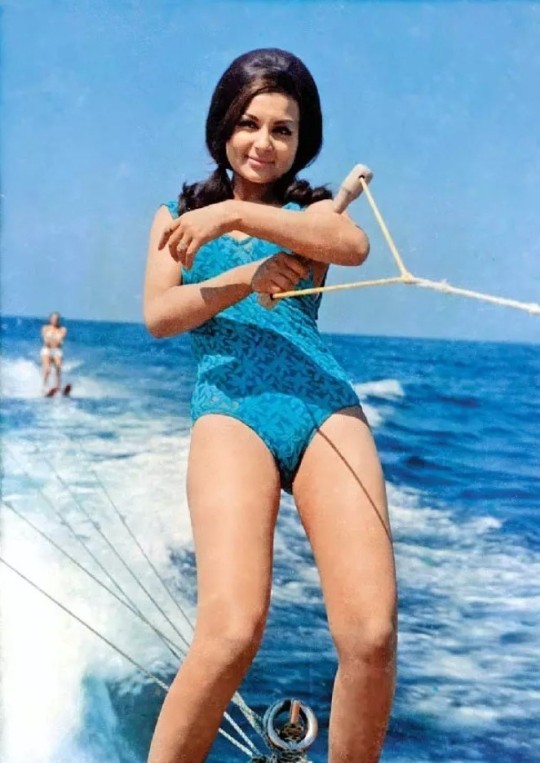
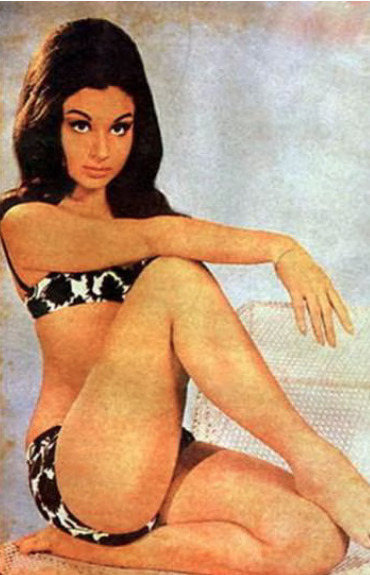

"One of the most well-known Bollywood actresses of all time!"
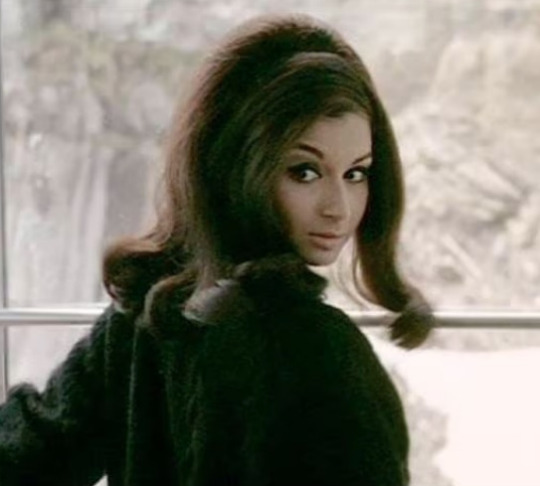
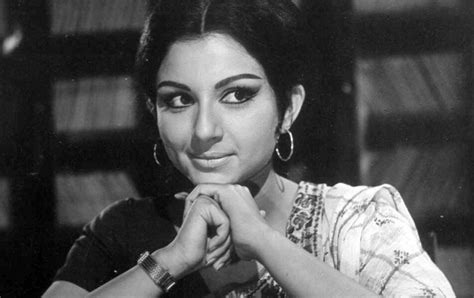
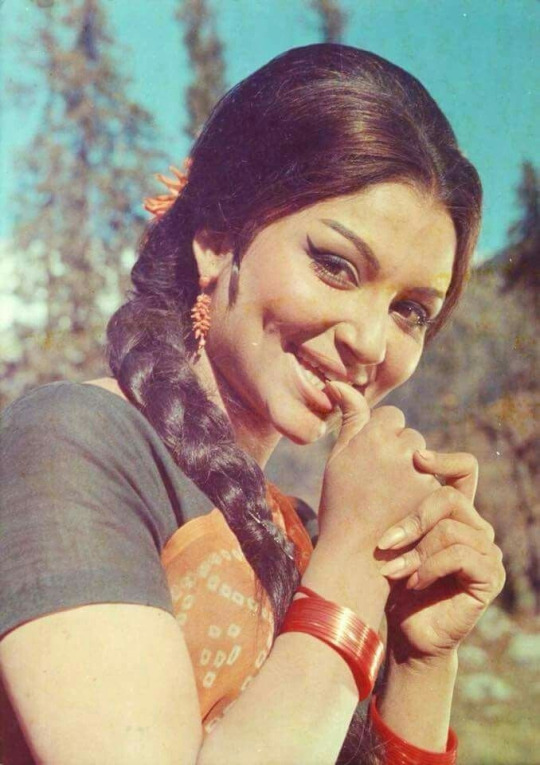
Pola Negri:
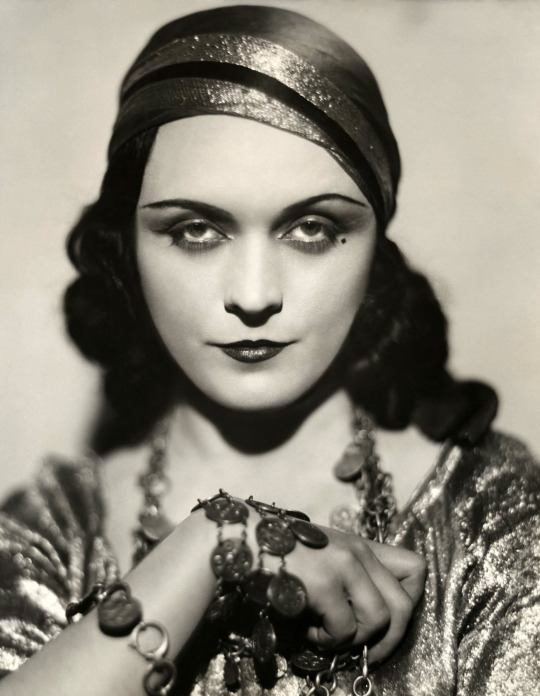
A tempestuous green-eyed vamp of the silent screen, she tantalized with both her onscreen and offscreen romances. Rocked a Polish accent - well, once there was sound! A true proficient at promoting herself and using all possible tools to do so - from a dead Rudolf Valentino to a cheetah named Teddy, the latter of which she brought to a press conference.

First European actress to be contracted by Hollywood! She survived poverty and illness to become The Queen of Tragedy, she divorced a count to date stars like Charlie Chaplin and Rudolph Valentino, then spent the rest of her life living with Margaret West in what could have been a romantic relationship.
I don't have much to say about her actual career, personal life, etc. but I just need everyone to see how hauntingly beautiful her face is. I haven't been able to stop thinking about her since the first time I saw her LOL like its pretty clear why she was such a star
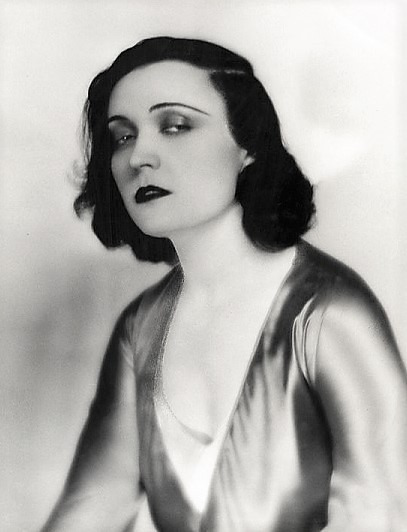
250 notes
·
View notes
Text
332: Talat Mahmood // Spring Blossoms
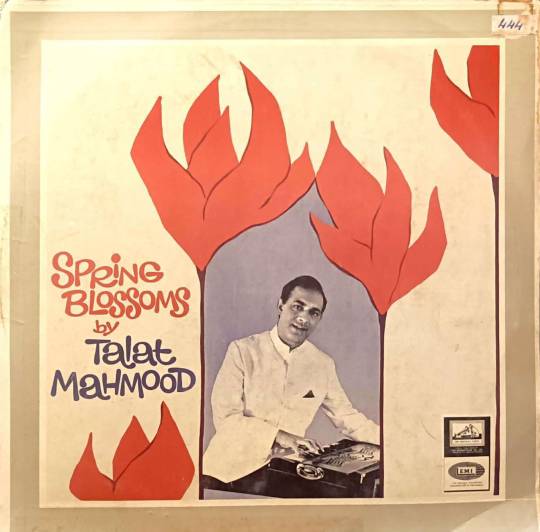
Spring Blossoms Talat Mahmood 1967, His Master's Voice
“Handsome, debonair Talat Mahmood has been the idol of listeners for the last several years. His mild mellow voice and expressive style makes him ideally suited for putting over on disc, lyrics with soulful poetic contents. The Geets and Ghazals rendered by him on this disc once again establish that he is the King of the Ghazal-singers and there is none to beat him in style and superb execution.”
That’s how a note on the back of the Spring Blossoms sleeve puts it, and I’ve few qualms. Mahmood’s voice is indeed as smooth as they come, and there is plenty of soul to these numbers, though the word several there is doing some strange work—by 1967 Mahmood had been a major star for a quarter century!
I’ve covered a couple of ghazal-related records in this series (see here and here), but as a refresher, the ghazal is a form of Arabo-Persian poetic ode (classically a simultaneous address to an absent lover and to God) that has remained popular in the East for nearly 1,500 years. The ghazal is based on metrically regular rhyming couplets, a repetitive structure which makes it easy to adapt to a musical form. Ghazals are found in both Indian art and pop music, and most of the legendary Bollywood playback singers (including Asha Bosle, Mohammad Rafi, and Lata Mangeshkar) had many in their repertoires.
The ghazal’s subject matter is inevitably rather blue, but they are also often celebratory in a mystically existential kind of way—life’s pain cannot be avoided, but a poet is allowed to twirl while he displays his wounds and counts his jutting ribs. In Mahmood’s case, any discomforting sorrow is pillowed by the gentle, velvet quaver in his voice. This is music which releases tears without leaving marks, like a bloodless surgery (don’t talk to me about reiki). Mind you, I don’t mean that as an attack on its sentimentality. Daily life for Mahmood’s audience was hard and tiring, and the opportunity to have their emotions tenderly exercised by beauty is a fine thing. These people didn’t need to have catharsis thrust upon them by the kinds of sonic or poetic terrorism that I, a sheltered western pervert, occasionally require to feel feelings. But I also enjoy this album a lot!
Spring Blossoms is quite pop for the standards of its pre-rock ‘n’ roll time and place, which is to say that it is slow, sweet, and elegant in an almost courtly way that has more in common tonally with western light classical or Eastern European folk than it does the Anglo-American pop of the period. Great titles too: “Those Who Listen to Me While Hugging Me, Know That My Love is Beautiful” sounds like Explosions in the Sky doing kids music, while “I Am Drunk, I Am Naked” could be either Rumi or Viagra Boys.
332/365
#talat mahmood#ghazal#playback#playback singer#bollywood#indian music#geets#'60s music#'50s music#'40s music#lata mangeshkar#asha bhosle#mohammed rafi#music review#vinyl record
4 notes
·
View notes
Text
The Tragic Life of Actress Vimmi :1960
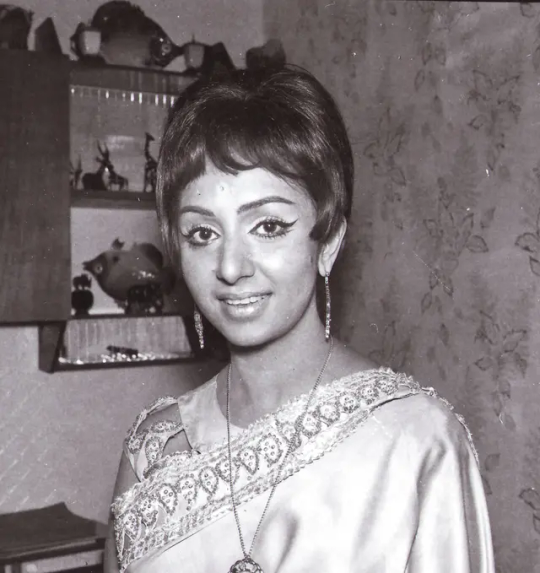
The Tragic Life Of Actress Vimmi
The Tragic Life Of Actress Vimmi is the Actress from Famous Bollywood film Hamraaz which was released in 1967 and directed by B.R. Chopra. Main leads in this movie with Vimmi are Sunil Dutt and Raaj kumar . The songs of the movie are also famous like ‘Tum Agar Saath Dene Ka Waada Karo’ and ‘neele gagan ke tale’

How Vimmi Become Star? Vimmi Born in 1943 ,she is an Indian actress who worked in many movies like Aabroo, Hamraaz etc. Her first film is Humraaz from which she got famous. She also worked in Punjabi film. Her last film Krodhi was released four years after her death. She became very popular after Humraaz and got many movies after that. She work with many famous actors like Shashi Kapoor,Sunil Dutt and Raaj Kumar. Which films vimmi work? Vimmi Started her career from humraaz which was release in 1967.After that she worked in Aabroo in 1968 and in punjabi film Nanak Nam Jahaz Hai in 1969. She also did a cameo in Guddi which was released in 1971. She also worked in Kahin Aar Kahin Par , Kahani Hum Sab Ki, Vachan,Premi Gangaram and Krodhi which was her last film With Whom Vimmi Got Married? Vimmi got married with Shiv Agarwal before started working in the film industry, who is businessman from calcutta. Her parents were not happy because of this marriage and her in laws also got angry because of her decision to became an actress. Her professional life was going very happy but she was not happy in her personal life as her parents and her in laws were not in talking terms with her. Her husband also leave her after his parents told him to do that and she got alone after that . Vimmi was very beautiful and smart but she can not act properly and slowly slowly people got to know that she is not able to act properly in films and that’s why there was time when she got less work in films and after that she started drinking alcohol How did vimmi Died? Vimmi was living alone after her husband leave her.She became alcoholic she got nothing in films .Vimmi needs a support from someone as she was very alone at that time, so she started living with a producer whos name was jolly but her destiny was so bad that he didn't help her but used her for his wrong deeds and started exploiting her and told her that is she want to work in film industry she has to spend time with producers more often then you will get work also and money also after this she broke completely and started drinking more alcohol after that her liver got damaged. She died on 22 August 1977 and her life was so bad that there is no one for her when she died.She died in general ward of nanavati Hospital and her dead body was carried in hand cart.This was the saddest life of a famous actress which many people doesn’t know. There is a few actor and actress from this industry like vimmi whose life is not at all happy. A common man always have dream to become famous like Bollywood actors like they have money, fans and popularity but no one knows the dark side of this industry. We knows about them when we see them on screen continuously but after they didn’t get work then no one will recognize them before they got in any controversy or they die. Vimmi is one of them who got famous in movies but there are many few people who knows about her Conclusion from this is people should avoid drinking Alcohol as it is not good for our health. You can Also Read Read the full article
1 note
·
View note
Text
Juhi Chawla
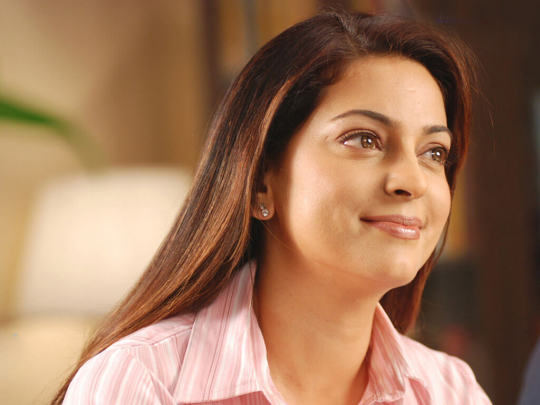
This Biography is about one of the best celebrity of the world Juhi Chawla including his Height, weight,Age & Other Detail... Express info Real Name Juhi S Chawla Nick Name N/A Profession Actor, Model, Producer Age (as in 2023) 55 Years old Physical Stats & More Info Height in centimeters- 163 cm in meters- 1.63 m in Feet Inches- 5’ 4” Weight in Kilograms- 56 kg in Pounds- 123 lbs Figure Measurements 34-26-34 Eye Color Dark Brown Hair Color Black Personal Life of Juhi Chawla Date of Birth 13 November 1967 Birth Place Ambala, Haryana, India Nationality Indian Hometown Mumbai, Maharashtra, India School Fort Convent School, Mumbai College Sydenham College, Mumbai Education Qualifications Graduation with specialization in HR Debut Film Debut: Sultanat (1986) Family Father- Late Dr. S. Chawla (Worked as an officer of the Indian Revenue Service (IRS)) Mother- Late Mona Chawla (Worked in housekeeping department of Oberois) Brother- Late Sanjeev Chawla (aka Bobby Chawla) (Elder, Former CEO of Red Chillies Entertainment) Sister- Late Sonia Chawla Best Friends Religion Hinduism Home Address Ritz Road, Malabar Hill in South Mumbai Hobbies Reading, yoga Like & DisLike N/A Favourite Things Of Juhi Chawla Favourite Food Paneer Shashlik, Dosa, Rasmalai, Gulab Jamun, Caramel Custard Favourite Actress Sridevi Favourite Actor Shah Rukh Khan, Aamir Khan Favourite Colors Green, White, Black Favourite Film Bollywood: Hum Hai Rahi Pyaar Ke Favourite Sports Tennis, Basket Ball Favourite Perfume Jeane Paul Gautier Favourite Song Ek Din Aap from the film Yes Boss Favourite Destination Switzerland Favourite Book The Alchemist by Paulo Coelho Boys , Affairs and More Of Juhi Chawla Marital Status Married Affairs Jay Mehta (Businessman) Marriage Date Year 1995 Husband Jay Mehta (Businessman, m.1995-present) Children Son- Arjun Mehta (born in 2003) Daughter- Jhanvi Mehta (born in 2001) Style Of Juhi Chawla Cars Collection Jaguar, Audi Q7 Bikes Collection N/A Earning Money of Juhi Chawla Net Worth $10 million Salary per Film 25 lakh /film (INR, in 1995) This Biography written by www.welidot.com Read the full article
0 notes
Text
From `Mere Sapno Ki Rani` to `Roop Tera Mastana`: Exploring Kishore Kumar And Rajesh Khanna`s Greatest Hits
Get ready to take a nostalgic trip down memory lane as we explore the greatest hits of two legends who ruled the hearts of millions in the 70s – Kishore Kumar and Rajesh Khanna. From the soulful “Mere Sapno Ki Rani” to the groovy “Roop Tera Mastana”, their music has stood the test of time and continues to captivate audiences even today. Join us on this musical journey as we celebrate their timeless melodies, unforgettable lyrics, and unparalleled chemistry that made them an inseparable duo in Bollywood history.
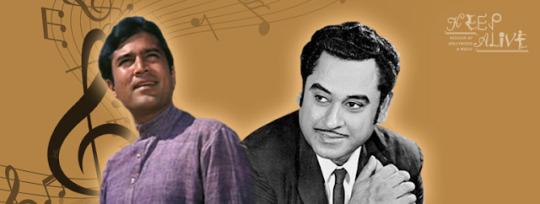
Introduction Kishore Kumar and Rajesh Khanna were two of the most popular actors and singers of Indian cinema during the 1970s. They worked together on numerous films and songs, many of which became huge hits. In this article, we’ll explore some of their greatest hits, from the classic “Mere Sapno Ki Rani” to the more recent “Roop Tera Mastana”. Kishore Kumar was known for his unique voice and style of singing, which was often imitated by other singers. He also had a great range, being able to sing both fast paced songs and slower ballads. Rajesh Khanna, on the other hand,was known for his good looks and charm, which helped him become one of the most popular actors of his time. Together, these two created some of the most iconic songs in Indian cinema. So let’s take a look at some of their greatest hits!
Kishore Kumar – The Melodious Singer and Music Composer Kishore Kumar was a singer and music composer who was popular in the 1950s and 1960s. He is known for his melodious voice and for his ability to compose catchy tunes. Some of his most popular songs include “Mere Sapno Ki Rani”, “Roop Tera Mastana” and “Pyaar Deewana Hota Hai”. Kumar was born in Kolkata, India, on 4 August1929. His father, Kunjalal Ganguly, was a lawyer and his mother, Gouri Devi, was a housewife. Kunjalal was also a singer and often sang at events and weddings. Gouri Devi would often accompany him on the harmonium. Kumar’s elder brother, Ashok Kumar, was an actor who later became a film director. ‘Kishore Kumar’ and started his cinema career as a chorus singer at Bombay Talkies, where his brother worked. Music director Khemchand Prakash gave Kumar a chance to sing “Marne Ki Duayen Kyon Mangu” for the film Ziddi (1948). After this, Kumar was offered many other assignments, but he was not very serious about a film career. In 1949, he settled in Bombay. Apart from being a playback singer, Kumar was also an accomplished music composer. He composed several songs for films and albums throughout his career. Some of his famous compositions include “Haal Kaisa Hai Janaab Ka”, “Ek Ladki Bheegi Bhagi Si”, and the evergreen classic, “Aane Wala Pal”. Kumar was also an actor, appearing in some Hindi films between 1949 and 1967. Some of his most notable roles were in the films “Chalti Ka Naam Gaadi” (1958), “Door Gagan Ki Chaon Mein” (1964) and “Half Ticket” (1962).
Rajesh Khanna – Bollywood’s First Superstar Rajesh Khanna was born Jatin Khanna on December 29, 1942 in Amritsar, India. Rajesh Khanna’s career in the Hindi film industry, also known as Bollywood, spanned over four decades. Khanna is often referred to as “Bollywood’s first superstar” due to his immense popularity during the 1970s. He starred in some of Bollywood’s most iconic films such as Kati Patang (1971), Anand (1971), Amar Prem (1972), and Namak Haraam (1973). Rajesh Khanna passed away on July 18, 2012 at the age of 69.
The Unbeatable Combination of the Two Superstars Kishore Kumar and Rajesh Khanna were two of the biggest superstars of their time. They had a unique chemistry that was unmatched by any other actor-singer duo. Their songs were always a hit with the audience, whether it was a romantic ballad or an upbeat dance number. Some of their most popular songs include “Mere Sapno Ki Rani”, “Roop Tera Mastana”, “Agar Tum Na Hote”, and “Kabhi Kabhi Mere Dil Mein”. Each one of these songs is special in its own way and has been cherished by fans over the years. What made Kishore Kumar and Rajesh Khanna’s partnership so special was the fact that they brought out the best in each other. Kishore Kumar’s playful personality complemented Rajesh Khanna’s intensity perfectly. Together, they created some truly magical moments on screen that are still remembered fondly by fans today.
Greatest Hits from Kishore & Rajesh Kishore Kumar and Rajesh Khanna were two of the most popular actors and singers of their time. They collaborated on many hit songs that are still loved today. Here are some of their greatest hits: “Mere Sapno Ki Rani”: This song is from the film “Aradhana” and is one of Rajesh Khanna’s most famous songs. The song is a romantic ballad that expresses the protagonist’s love and admiration for his dream girl, whom he has not yet met. He describes her as the queen of his dreams and expresses his longing to make her his own. The song has become an iconic representation of Rajesh Khanna’s charisma and charm, and Kishore Kumar’s soulful voice adds to its timeless appeal. “Ek Ajnabee Haseena Se”: This song is from the film “Ajnabee” sung by Kishore Kumar. The song is a romantic ballad in which the male protagonist describes his encounter with a mysterious and beautiful stranger who has captured his heart. He expresses his desire to get to know her better and asks for her love and affection. The soft and melodious tune, combined with Kishore Kumar’s soulful voice, makes the song an all-time favorite among Bollywood music fans. “Ye Jo Mohabbat Hai”: This song is from the film “Kati Patang” and was composed by R. D. Burman. It was sung by Kishore Kumar. The soundtrack became as beloved as the film itself, with songs that were to take their place among the classics. The song is also remembered for its iconic music video featuring the lead actor, Rajesh Khanna, who was known for his charming and romantic performances. “Zindagi Ka Safar”: This song is a classic Hindi song from the 1970 Bollywood film “Safar,” featuring a beautiful collaboration between the legendary singer Kishore Kumar and the iconic actor Rajesh Khanna. It is a poignant reflection on the ups and downs of life’s journey. With its beautiful melody and heartfelt lyrics, “Zindagi Ka Safar” is a timeless gem that continues to resonate with audiences today. – Hamen Tumse Pyar Kitna This song is a classic Hindi song from the 1981 Bollywood film “Kudrat” that features the soulful voice of Kishore Kumar and the magnetic charisma of Rajesh Khanna. Kishore Kumar’s emotive rendition and Rajesh Khanna’s captivating on-screen presence have made it a beloved hit that continues to be cherished by Bollywood music lovers.
Rajesh Khanna & Kishore Kumar’s Unbeatable Collaboration Kishore Kumar and Rajesh Khanna were a legendary duo in the Indian film industry during the 1970s. Kishore Kumar was a prolific singer with a unique voice, known for his versatility and ability to convey a wide range of emotions through his singing. Rajesh Khanna, on the other hand, was a charismatic actor who was a heartthrob of the masses, known for his romantic roles and his ability to connect with audiences.Together, Kishore Kumar and Rajesh Khanna created some of the most memorable songs and films of the era. Their collaborations produced a string of superhit films such as “Aradhana,” “Anand,” “Amar Prem,” and “Mere Jeevan Saathi,” among many others. The songs from these films, many of which were sung by Kishore Kumar, continue to be beloved classics that are cherished by music lovers even today. Kishore Kumar’s soulful voice was the perfect complement to Rajesh Khanna’s charming on-screen presence, and the two were able to create an unbeatable combination that captured the hearts of audiences across the country. Their collaborations remain an integral part of the Indian film industry’s legacy and have left an indelible mark on the hearts of generations of fans.
Conclusion
Kishore Kumar and Rajesh Khanna were an unbeatable combination in the 1970s. Their on-screen chemistry was undeniable, and their string of hits together cemented them as one of Bollywood’s most popular pairs. From light-hearted comedies like Chupke Chupke to tearjerkers like Amar Prem, they proved time and again that they had the range to tackle any genre. There will never be another team quite like Kishore Kumar and Rajesh Khanna. Their films defined a generation, and their impact is still felt today
#music#old hindi songs#binaca geetmala#filmfareawards#yesudas song lyrics#binaca geetmala 1960 to 1970#old hindi songs lyrics#binaca geetmala hindi songs#filmfare award winners 1960#aesthetic
0 notes
Text
A.R. RAHMAN ALL SONGS LIST
A.R. Rahman, also known as Allah Rakha Rahman, is an Indian music composer, singer, and songwriter. He was born on January 6, 1967, in Chennai, Tamil Nadu, India.
Rahman started his career as a composer in 1992 with the Tamil film "Roja" and gained instant recognition for his work. He went on to compose music for several Bollywood and Tamil films, including "Bombay," "Dil Se," "Taal," "Lagaan," "Rang De Basanti," "Rockstar," and many more.
A.R. Rahman has won numerous national and international awards for his music, including two Academy Awards, two Grammy Awards, a BAFTA Award, a Golden Globe, and many more. He is also known for his work in the theatre industry and has composed music for several stage productions and musicals.
Apart from his work in the film and theatre industry, A.R. Rahman has also released several albums and collaborated with several international artists. He has also composed music for various advertisements and documentaries.
A.R. Rahman is considered to be one of the greatest music composers in India and has been credited with revolutionizing the music industry with his unique style and experimentation with different genres and instruments.
Vera Level Sago Song Lyrics
Dhakka Laga Bukka Song Lyrics
Phuljhadiyon Song Lyrics
Hututu Song Lyrics
Rihaayi De Song Lyrics
Agar Tum Saath Ho Song Lyrics
Toofan Si Kudi Song Lyrics
Garda Song Lyrics
Rait Zara Si Song Lyrics
Chaka Chak Song Lyrics
Tere Rang Song Lyrics
Little Little Song Lyrics
Tumhein Mohabbat Song Lyrics
Chaka Chakalathi Song Lyrics
Main Toh Main Hoon Lyrics
Tum Bhi Raahi Song Lyrics
Chola Chola Song Lyrics
Devaralan Aattam Song Lyrics
Mallipoo Song Lyrics
Unna Nenachadhum Song Lyrics
Marakkuma Nenjam Song Lyrics
Ponni Nadhi Song Lyrics
Kaveri Se Milne Song Lyrics
0 notes
Text
Lyrics Kaanha Kaanha Aan Padi Main Tere Dwaar
Lyrics Kaanha Kaanha Aan Padi Main Tere Dwaar
Lyrics Kaanha Kaanha Aan Padi Main Tere Dwaar – Song contents: Lyrics in EnglishHindi LyricsYouTube VideoMore Lyrics in English | Lyrics Kaanha Kaanha Aan Padi Main Tere Dwaar | Shagird-1967 | Lata Mangeshkar | Saira Banu Humm…Humm…Humm…Kaanha (2)Aan Padi MainTere DwaarKaanha (2)Aan Padi MainTere Dwaar MoheChaakarSamjh NihaarKaanha (2)Aan Padi MainTere Dwaar…………. Antakshari Songs from…
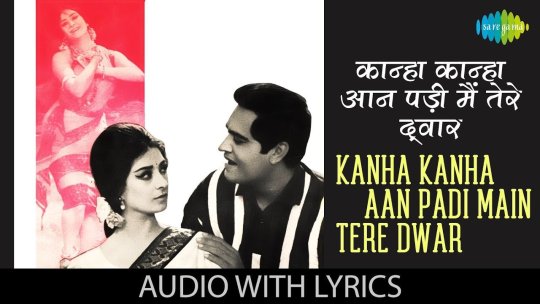
View On WordPress
#A to Z Devotional Songs#Achala Sachdev Songs#All Time Best Bollywood Devotional Songs#All Time Best Songs of Saira Banu#Antakshari Songs from K#Best Bollywood Kanha Songs#Best Bollywood Songs of 1967#Best Devotional Songs of 1960s#Best Krishna Hindi Songs#Best of Lata Mangeshkar and Laxmikant-Pyarelal#Best of Laxmikant-Pyarelal#Best of Laxmikant-Pyarelal and Majrooh Sultanpuri#Best of Majrooh Sultanpuri and Lata Mangeshkar#Best Songs of 1967#Best Songs of Majrooh Sultanpuri#Bollywood Kanha Songs#Bollywood Songs of 1967#Devotional Songs of 1967#Filmy Devotional Songs#Hindi Devotional Songs#Hindi Song Lyrics Starting from K#Hindi Songs of 1967#krishna Janmashtami Special Bollywood Songs#Lata Mangeshkar Devotional Songs#Lata Mangeshkar Songs#Laxmikant-Pyarelal and Majrooh Sultanpuri Songs#Lyrics Starting from K#Nazir Hussain Songs#Saira Banu Hit Songs#Saira Banu Songs
0 notes
Photo
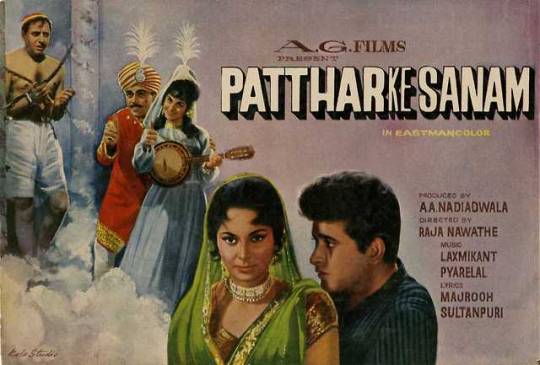
“Patthar Ke Sanam” (1967), starring Waheeda Rehman, Mumtaz, Manoj Kumar, Mehmood and Pran
#Patthar Ke Sanam#Waheeda Rehman#Mumtaz#Manoj Kumar#Mehmood#Pran#Old Bollywood#1967#1960s#Indian Cinema#Bollywood2#Bollywood#Vintage Bollywood#song booklets#role: Taruna
12 notes
·
View notes
Text
Shalimar 1978 Songs Pk

Shalimar 1978 Songs Pk Songs
Shalimar 1978 Songs Pk Subban
Shalimar 1978 Songs Pk Song
This will remove all the songs from your queue. Are you sure you want to continue? Clear currently playing song. One Two Cha Cha Cha(From 'Shalimar') Lyrics. Old songs indeed have an unmatchable aura from the rest of the songs. These songs, with the combination of meaningful lyrics and melodious tunes, helped in creating a great hype for their film. While some songs are famous by their title, some are famous by the cast that performs in the songs. SUBSCRIBE for the best Bollywood videos, movies, scenes and songs, all in ONE channel: On the run from the police, S.S. Kumar, a thief, comes across a private invitation to. About Us Shalamar Hospital is committed in the delivery of its tripartite mission of exemplary patient care, high-impact research and education. Over the last 44 years, Shalamar Hospital has evolved into a premier tertiary care medical facility with 500.
Category :Bollywood Songs
A number of songs about turmoil in relationships have been made in Hindi films. It’s not easy to get back to normal after a split with the one you love. This article showcases a detailed perspective of the best Bollywood Breakup songs and Heartbreak songs.
Parting ways with the one you love is never easy. Not every love story has a happy ending. The sentiments associated with a breakup have been expressed colloquially in Hindi films. Since its early days the Hindi film industry has depicted varied emotions centrifugal to lovers parting ways. Emotional turmoil is an aspect that has been thoughtfully captured through songs in Hindi films. Since the black and white era, songs about breakup and heartache have been exceedingly popular. Songs about lovers parting ways are exceedingly popular with Bollywood aficionados. People are able to relate with lyrics in breakup songs, and that’s why these songs are close to the heart of many.
Listeners are able to connect with emotions and feelings conveyed through breakup songs. Heartache and breakups is a bitter slice of reality that is painful, and it’s this pain that is expressed poetically through Bollywood breakup songs. The Hindi film industry is known for its high caliber lyricists. Lyricist’s give new life and meaning to songs with words. Lyrical melodies in Bollywood songs have charmed audiences in different decades. The warmth of emotion that oozes forth in Bollywood breakup songs has mesmerized audiences belonging to different age groups.
Breakup songs and heartbreak songs are popular with both youngsters and the older generation. While youngsters relate to present day songs, the older generation loves listening to sad songs from the decades gone by. The sentiments expressed through breakup songs in Hindi films have touched hearts. Emotive lyrics in breakup songs bring back memories of the past. Listening to songs about breakups or heartbreak help you deal with life as it comes. While opinions differ in regard with whether listening to breakup songs impact a person positively or negatively, the truth of the matter is lyrics in songs about heartbreak can only make you stronger and move forward for a better life.
The lines below showcase a comprehensive list of the best Bollywood breakup songs.
100 Greatest Bollywood Breakup Songs and Heartbreak Songs
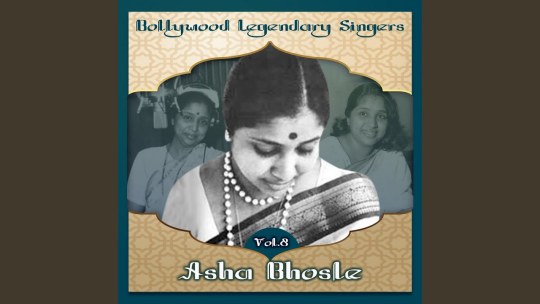
Tadap Tadap Ke- Hum Dil De Chuke Sanam (1999)
Jag Soona Soona Lage- Om Shanti Om (2007)
Tanahayee- Dil Chahta Hai- (2001)
Jeena Yahan Marna Yahan- Mera Naam Joker (1970)
Bin Tere- I Hate Love Stories- (2010)
Yeh Duniya Yeh Mehfil- Heer Ranjha (1970)
Kabira- Yeh Jawaani Hai Deewani- (2013)
Tum hi Ho- Aashiqui 2 (2013)
Saathi Re Tere Bina Bhi Kya Jeena- Muqaddar Ka Sikandar (1978)
Tu Jaane Na- Ajab Prem Ki Ghazab Kahani- (2009)
Jaane Tu Meri Kya Hai- Jaane Tu… Ya Jaane Na (2008)
Agar Tum Saath Ho- Tamasha (2015)
Teri Meri- Bodyguard (2011)
Tujhe Bhula Diya- Anjaana Anjaani- (2010)
Mora Piya- Raajneeti (2010)
Tere Bin- Bas Ek Pal (2006)
Pyaar Hai Ya Sazaa- Salaam-e-Ishq (2006)
Bhula Dena- Aashiqui 2 (2013)
Jab Rulana Hi Tha- Aggar (2007)
Tujhe Yaad Na Meri Aaye- Kuch Kuch Hota Hai (1998)
Pardesi Pardesi Jaana Nahin- Raja Hindustani (1996)
Tujhe Sochta Hoon- Jannat 2 (2012)
Woh Lamhe Woh Baaten- Zaher (2005)
Chaha Hai Tujhko- Mann (1999)
Tune Jo Na Kaha- New York (2009)
Dil Ke Armaan Aanshuo Main Beh Gaye- Nikaah (1982)
Sunn Raha Hai- Aashiqui 2 (2013)
Hasi- Hamari Adhuri Kahani- (2015)
Tere Liye- Veer Zaara (2004)
Zindagi Ka Safar- Safar (1970)
Laal Ishq- Goliyon Ki Rasleela…Ramleela (2013)
Hone So Batuyaan- Fitoor (2016)
Tere Naam- Tere Naam (2003)
Manchala- Hasee Tooh Phasee (2014)
Kaise Main Kahon Tujhse- Rehna Hai Tere Dil Main (2001)
Ae Dil Hai Mushkil- Ae Dil Hai Mushkil (2016)
Ab Tere Bin- Aashiqui (1989)
Lambi Judaai- Hero (1983)
Main Shayar Badnaam- Namak Haram (1973)
Alvida- D- Day (2013)
Main Tenu Samjhawan- Humpty Sharma Ki Dulhania (2014)
Chingari Koi Bhadake- Amar Prem (1971)
Re Piya- Aaja Nachle (2007)
Koi Yeh Kaise Bataye- Arth (1983)
Tere Bina Zindagi Se Koi- Aandhi (1975)
Din Dhal Jaaye Haaye- Guide (1965)
Hum Bekhudi Mein Tumko Pukare- Kala Pani (1958)
Jiye Toh Jiye Kaise- Saajan (1991)
Pyar Manga Hai Tumhi Se- College Girl (1978)
Waqt Ne Kiya Kya Hansi Sitam- (Kaagaz Ke Phool) (1959)
Mera Kuchh Saaman- Ijaazat (1988)
Dooriyan- Love Aaj Kal(2009)
Justjoo Jiski Thi Usko- Umrao Jaan (1981)
Teri Galiyon Mein Na Rakhenge- Hawas (1971)
Poochoo Na Kaise Maine- Meri Surat Teri Aankhen (1963)
Abhi Mujh Mein Kahin- Agneepath (2012)
Laayi Ve Ne Gayi, Tey Nibhayi Vi Na Gayi- Chalte Chalte (2003)
Bhare Naina- Ra. One (2011)
Do Pal- Veer Zaara (2004)
Yun Hasraton Ke Daag- Adalat (1958)
Zindagi Mein Koi Kabhi Aaye Na Rabba- Musafir (2004)
Dil De Diya Hai- Masti (2004)
Priya Priya- Dil (1990)
Toote Huye Khwabon Me- Madhumati (1958)
Hum Bewfa Hargiz Na Thay- Shalimar (1978)
Jiyien Kyun- Dum Maaro Dum (2011)
Aaoge Jab Tum Sajna- Jab We Met (2007)
Teri Yaad Aati Hain- Saudagar (1991)
Jeena Jeena- Badlapur (2015)
Jeeta Tha Jiske Liye- Dilwale (1994)
Dil Mera Churaya Kyon- Akele Hum Akele Tum (1995)
Who Shaam Kuchj Ajeeb Thi- Khamoshi (1969)
Mujhe Teri Mohabbat Ka Sahara- Aap Aye Bahaar Aye (1971)
Tu Pyaar Hain Kisi Aur Ka- Dil Hai Ki Maanta Nahi (1991)
Zindagi Ke Safar Mein Guzar Jaate- Aap Ki Kasam (1974)
Jaane Kahan Gaye Who Din- Mera Naam Joker (1970)
Koi Hota Jisko Apna- Mere Apne (1971)
Kya Hua Tera Wada- Hum Kisise Kam Naheen (1977)
Shikaayat Hain- Jism (2003)
Sach Keh Raha Hai Deewana- Rehnna Hai Tere Dil Mein (2011)
Aur Is Dil Mein Kya Rakha Hai- Imaandaar (1987)
Chod Gaya Balam- Barsaat (1949)
Banake Kyun Bigada Re- Zanjeer (1973)
Chupana Bhi Nahi Aata- Baazigar (1993)
Mere Toote Huye Dil Se- Chhalia (1960)
Mere Dushman Tu Meri Dosti Ko Tarse- Aaye Din Bahaar Ki (1966)
Mere Piya- Tere Mere Sapne (1996)
Toh Phir Aao- Awarapan (2007)
Shisha Ho Ya Dil Ho- Aasha (1980)
Awaarapan Banjarapan- Jism (2003)
Dil Lagane Ki Do Na Saza- Anmol (1993)
Achha Sila Diya Tune Mere Pyaar Ka- Sanam Bewafa (1993)
Yeh Safar- 1942: A Love Story- (1994)
Mera Yaar Mila Dey Saaiyaan- Saathiya (2002)
Koi Jab Tumhara Hriday Tod De- Purab Aur Paschim (1970)
Aye Ajnabi Tu Bhi Kabhi- Dil Se (1998)
Hum Thay Jin Ke Saharay- Safar (1970)
Ab Naam Mohabbat Ke Ilzaam Yeh Aaya Hain- Ghulam (1998)
Tota Tota Sajan Se Kehna- First Love Letter (1991)
Rula Ke Gaya Sapna Mera- Jewal Thief (1967)
Let us know how you like this article. Like it and Rate it below.
60.43K 3
4
Next Post
200 Greatest Hard Rock Love Songs and Rock Ballads
Shalimar 1978 Songs Pk Songs

200 Greatest Classic Bollywood Songs
The repertoire of classics in the Hindi film industry is incomparable. This article showcases a list of best classic Bollywood songs..
100 Greatest Bollywood Dance Songs For New Year Parties
The vibe Bollywood music brings onto the dance floor is like no other. The lines below showcase a list of the best Bollywood dance songs for New Year parties.
Shalimar 1978 Songs Pk Subban
Top 100 Bollywood Dance Songs For Freshers’ Parties
Music and dance is the essence of a freshers’ party. Students like to have a good time dancing to the tunes of different songs at a freshers’ bash.
Post Your Comment
tumbou
Oh my God Tujhey Bhula Diya is my all time favourite. It hits the cord straight of my heart. It's lyrics has so much reality in it. Zindagi Kay safar main guzar jaatay is another reality based song that brings tears
reply 0

biju
Music has become an integral part pf our daily life. If you listen music, you would not feel any pain.
Shalimar 1978 Songs Pk Song
reply 0

9 notes
·
View notes
Text
Shankar Mahadevan: The Versatile Maestro of Indian Music
Shankar Mahadevan is a name that resonates deeply in the world of Indian music. Known for his unparalleled versatility and passion, he has carved a unique niche for himself as a singer, composer, and educator. His ability to seamlessly transition between classical, Bollywood, and contemporary music genres has made him one of the most celebrated musicians of our time. Beyond his immense talent, Shankar is a symbol of dedication and innovation, continually pushing the boundaries of Indian music.
Early Life and Musical Roots:
Born on March 3, 1967, in Chembur, Mumbai, Shankar Mahadevan grew up in a Tamil-speaking family with a strong inclination towards the arts. From a young age, his parents recognized his prodigious talent and encouraged him to pursue music. His training in Carnatic music began early, under the guidance of Pandit Shrinivas Khale, where he mastered intricate ragas and honed his vocal techniques.
While excelling in music, Shankar also pursued a degree in Computer Science and Software Engineering. However, his passion for music remained unwavering. Despite a promising career in the tech industry, he chose to dedicate his life to music, a decision that would later redefine the Indian music landscape.
Career Milestones:
Shankar Mahadevan’s career took off in the 1990s with the release of his groundbreaking album Breathless. The title track, composed to sound like it was sung in a single breath, showcased his vocal mastery and became an instant sensation. The song not only brought him widespread recognition but also established him as a creative force in the music industry.
Shankar’s career reached new heights when he teamed up with Ehsaan Noorani and Loy Mendonsa to form the iconic trio Shankar–Ehsaan–Loy. Together, they redefined Bollywood music with their unique ability to blend Indian classical elements with Western styles like rock, jazz, and blues. The trio’s debut film, Dil Chahta Hai (2001), was a monumental success, with its fresh and contemporary soundtrack striking a chord with the youth. Hits like “Jaane Kyon” and “Tanhayee” remain timeless classics.
Over the years, Shankar–Ehsaan–Loy delivered numerous chart-topping soundtracks, including Kal Ho Naa Ho, Rock On!!, Bunty Aur Babli, Zindagi Na Milegi Dobara, and 2 States. Their music is characterized by its diversity, with each album offering a mix of soulful ballads, energetic anthems, and experimental compositions.
Beyond Bollywood:
While Shankar Mahadevan is best known for his work in Bollywood, his musical repertoire extends far beyond the silver screen. He has collaborated with renowned international artists like Zakir Hussain, John McLaughlin, and Chaka Khan, showcasing his ability to transcend cultural and musical boundaries. As a member of the fusion band Shakti, Shankar explored the intersection of Indian classical music and jazz, creating a global impact.
In addition to his performances, Shankar has been a passionate advocate for music education. In 2011, he launched the Shankar Mahadevan Academy, an online platform dedicated to teaching Indian classical and contemporary music. The academy has made music education accessible to students across the globe, nurturing a new generation of musicians. Through interactive courses and workshops, Shankar has ensured that the rich heritage of Indian music is preserved and passed on.
Personal Life and Values:
Shankar Mahadevan is known for his humility and grounded personality. Despite his immense success, he remains deeply connected to his roots and continues to find joy in teaching and mentoring young talent. He attributes his achievements to the unwavering support of his family, particularly his wife, Sangeeta, and their two sons, Siddharth and Shivam, both of whom have shown an interest in music.
Musical Philosophy:
What sets Shankar Mahadevan apart is his ability to balance tradition with innovation. He believes that music should evolve while staying true to its roots. His compositions often reflect this philosophy, combining the technical precision of classical music with the emotional depth of contemporary styles. Whether it’s a soulful ghazal, a high-energy Bollywood number, or a fusion experiment, Shankar’s music resonates with audiences of all ages.
Awards and Recognition:
Over his illustrious career, Shankar Mahadevan has received numerous accolades. He has won four National Film Awards for Best Male Playback Singer and Best Music Direction, along with several Filmfare Awards. His contributions to music have also earned him honorary doctorates and recognition from cultural institutions worldwide.
Legacy and Future:
Shankar Mahadevan’s impact on Indian music is profound. He has not only entertained millions but also inspired countless musicians to pursue their dreams. Through his academy, he continues to shape the future of Indian music, ensuring that it remains vibrant and relevant in an ever-changing world.
As Shankar looks to the future, his focus remains on innovation and collaboration. He is constantly exploring new genres and experimenting with different forms of expression. His recent ventures include scoring for web series and independent projects, reflecting his adaptability and willingness to embrace change.
Conclusion:
Shankar Mahadevan is more than just a musician; he is a cultural icon who has redefined what it means to be an artist in the modern era. His journey from a young boy in Mumbai to an internationally acclaimed musician is a testament to his talent, hard work, and vision. By bridging the gap between tradition and modernity, Shankar has created a legacy that will inspire generations to come.
Dive into the world of Shankar Mahadevan by exploring his discography, from Breathless to the soundtracks of iconic Bollywood films. Witness the evolution of a musician who has continually pushed the boundaries of creativity.
0 notes
Text
Post # 119
Jarnail Hari Singh Nalwa
Mere Desh Ki Dharti Sona Ugle is a patriotic song from the 1967 Bollywood movie - Upkar, which cemented Manoj Kumar's brand as Bharat Kumar. The last para of that song goes like this...

This stanza eulogizes many well known Indian personalities - Gautam Buddha, Guru Nanak, Gandhiji, Subhash Chandra Bose, Rabindranath Tagore, Bal Gangadhar Tilak, Lal Bahadur Shastri, Bhagat Singh and Jawaharlal Nehru. Along with such eminent personalities, this song also mentions Hari Singh Nalwa. I hadn't heard about him until recently. I am not sure many people know him very well.
This post is about one of the greatest generals India has ever produced, the commander-in-chief of Maharaja Ranjit Singh's Sikh empire and a soldier who sent shivers through enemy ranks, but strangely whose name got lost in the annals of history - Jarnail Hari Singh Nalwa.
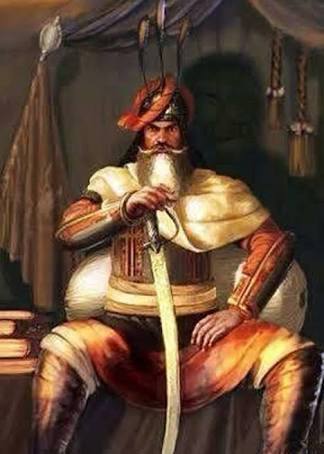
This fercious-looking man was born in Gujranwala, a city currently in Pakistan, famous for wrestling. His forefathers were officers in the Sikh army. But he lost his father when he was a kid.
In 1804, when he was in his teens, he was spotted by Maharaja Ranjit Singh in an annual talent hunt-cum- sporting event, where Hari Singh excelled in horse riding, sword fighting, wrestling and many competitive sports. He was inducted as one of Ranjit Singh's personal bodyguards.
One day, Maharaja Ranjit Singh and his retinue went to the jungle for hunting. Out of the blue, a tiger attacked Hari Singh and killed his horse. Declining help from others, Hari Singh is supposed to have single-handedly fought the tiger and killed it. Maharaja Ranjit Singh was so impressed that Hari Singh was given the titles Baagmaar (tiger-killer) and Nalwa (one with tiger-like-claws).

He was also recognized as a Sardaar and from here on he rose meteorically in Ranjit Singh's army to become his commander-in-chief, General, also called Jarnail.
Though he participated, planned or led dozens of battles, his most ferocious opponents were the Afghans. For centuries, Afghans would attack, loot, rape and plunder India.

They would enter India through the Kyber pass.

Hari Singh Nalwa took the Afghans on in the famed Battle of Jamrud in 1836, conclusively drove them away, and build a fort in Jamrud to ensure Khyber Pass was sealed for ever.

It is said that the Afghans weren't scared of the Brits, the Russians or the Americans - the three superpowers who tried to control them, but they were shit scared of Hari Singh Nalwa. It is also said that Afghan mothers used to threaten pesky kids that if they didn't mind their manners, Hari Singh Nalwa would come down to teach them a lesson. This is hard to believe, but harder still not to believe!
During his time, this is how big the Sikh empire became. He was, at various times, the Governor of Kashmir, Peshawar and Hazara.

He was also considered an able administrator. Maharaja Ranjit Singh had so much trust and faith in him as a loyal administrator that he allowed Hari Singh Nalwa to mint coins in his name.

Hari Singh Nalwa was also a town planner and architect. One of the towns founded by him is Haripur, which is still extant in Pakistan.
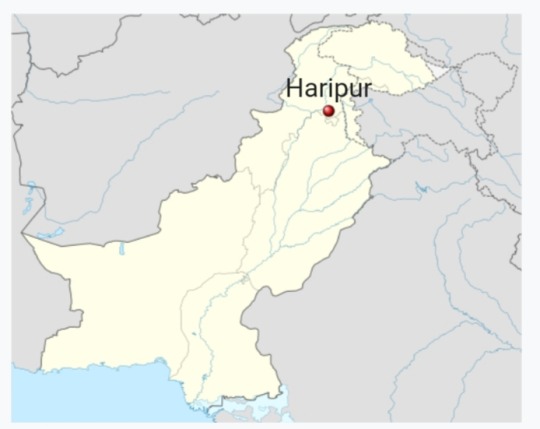
The story of his death is an unbelievable tale. In 1837, Dost Mohammed Khan, another Afghan, attacked Peshawar with a vast army. Though Hari Singh Nalwa was down with fever and camping elsewhere, he left for Peshawar immediately, sending request to Ranjit Singh for urgent reinforcements.
In Peshawar, he was fatally wounded and died. Before dying, he ordered his faithful lieutenants not to tell any one that he was dying. In order to boost the morale of his troops, he walked to the rampart of the fort so that enemy could see him and died standing in that posture.

The sight of Hari Singh Nalwa sent shivers down the Afghans. They waited one week before they realised he was dead. By that time, reinforcements had arrived. Hari Singh Nalwa lived a glorious life and died a glorious death.
#general#jarnail#hari singh nalwa#maharaja ranjit singh#sikh empire#nalwa#baaghmaar#afghans#khyber pass#jamrud#gujranwala#peshawar#kashmir#haripur
11 notes
·
View notes